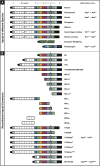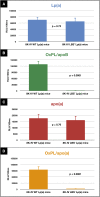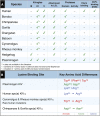Determinants of binding of oxidized phospholipids on apolipoprotein (a) and lipoprotein (a)
- PMID: 23828779
- PMCID: PMC3770094
- DOI: 10.1194/jlr.M040733
Determinants of binding of oxidized phospholipids on apolipoprotein (a) and lipoprotein (a)
Abstract
Oxidized phospholipids (OxPLs) are present on apolipoprotein (a) [apo(a)] and lipoprotein (a) [Lp(a)] but the determinants influencing their binding are not known. The presence of OxPLs on apo(a)/Lp(a) was evaluated in plasma from healthy humans, apes, monkeys, apo(a)/Lp(a) transgenic mice, lysine binding site (LBS) mutant apo(a)/Lp(a) mice with Asp(55/57)→Ala(55/57) substitution of kringle (K)IV10)], and a variety of recombinant apo(a) [r-apo(a)] constructs. Using antibody E06, which binds the phosphocholine (PC) headgroup of OxPLs, Western and ELISA formats revealed that OxPLs were only present in apo(a) with an intact KIV10 LBS. Lipid extracts of purified human Lp(a) contained both E06- and nonE06-detectable OxPLs by tandem liquid chromatography-mass spectrometry (LC-MS/MS). Trypsin digestion of 17K r-apo(a) showed PC-containing OxPLs covalently bound to apo(a) fragments by LC-MS/MS that could be saponified by ammonium hydroxide. Interestingly, PC-containing OxPLs were also present in 17K r-apo(a) with Asp(57)→Ala(57) substitution in KIV10 that lacked E06 immunoreactivity. In conclusion, E06- and nonE06-detectable OxPLs are present in the lipid phase of Lp(a) and covalently bound to apo(a). E06 immunoreactivity, reflecting pro-inflammatory OxPLs accessible to the immune system, is strongly influenced by KIV10 LBS and is unique to human apo(a), which may explain Lp(a)'s pro-atherogenic potential.
Keywords: kringles; lipoproteins; plasminogen.
Figures











Similar articles
-
A novel function of lipoprotein [a] as a preferential carrier of oxidized phospholipids in human plasma.J Lipid Res. 2008 Oct;49(10):2230-9. doi: 10.1194/jlr.M800174-JLR200. Epub 2008 Jul 1. J Lipid Res. 2008. PMID: 18594118
-
Oxidized phospholipids are present on plasminogen, affect fibrinolysis, and increase following acute myocardial infarction.J Am Coll Cardiol. 2012 Apr 17;59(16):1426-37. doi: 10.1016/j.jacc.2011.12.033. J Am Coll Cardiol. 2012. PMID: 22497821 Free PMC article.
-
Lipoprotein(A) with An Intact Lysine Binding Site Protects the Retina From an Age-Related Macular Degeneration Phenotype in Mice (An American Ophthalmological Society Thesis).Trans Am Ophthalmol Soc. 2015;113:T5. Trans Am Ophthalmol Soc. 2015. PMID: 26538774 Free PMC article.
-
Oxidized phospholipid modification of lipoprotein(a): Epidemiology, biochemistry and pathophysiology.Atherosclerosis. 2022 May;349:92-100. doi: 10.1016/j.atherosclerosis.2022.04.001. Atherosclerosis. 2022. PMID: 35606081 Review.
-
Inhibition of fibrinolysis by lipoprotein(a).Ann N Y Acad Sci. 2001;936:261-75. doi: 10.1111/j.1749-6632.2001.tb03514.x. Ann N Y Acad Sci. 2001. PMID: 11460483 Review.
Cited by
-
Emerging Therapeutic Options for Lowering of Lipoprotein(a): Implications for Prevention of Cardiovascular Disease.Curr Atheroscler Rep. 2016 Dec;18(12):69. doi: 10.1007/s11883-016-0622-1. Curr Atheroscler Rep. 2016. PMID: 27761705 Review.
-
Diet and Lp(a): Does Dietary Change Modify Residual Cardiovascular Risk Conferred by Lp(a)?Nutrients. 2020 Jul 7;12(7):2024. doi: 10.3390/nu12072024. Nutrients. 2020. PMID: 32646066 Free PMC article. Review.
-
Structure, function, and genetics of lipoprotein (a).J Lipid Res. 2016 Aug;57(8):1339-59. doi: 10.1194/jlr.R067314. Epub 2016 Apr 13. J Lipid Res. 2016. PMID: 27074913 Free PMC article. Review.
-
Lipoprotein(a) in Atherosclerotic Diseases: From Pathophysiology to Diagnosis and Treatment.Molecules. 2023 Jan 18;28(3):969. doi: 10.3390/molecules28030969. Molecules. 2023. PMID: 36770634 Free PMC article. Review.
-
Identification and analyses of inhibitors targeting apolipoprotein(a) kringle domains KIV-7, KIV-10, and KV provide insight into kringle domain function.J Biol Chem. 2020 Apr 10;295(15):5136-5151. doi: 10.1074/jbc.RA119.011251. Epub 2020 Mar 4. J Biol Chem. 2020. PMID: 32132173 Free PMC article.
References
-
- Dubé J. B., Boffa M. B., Hegele R. A., Koschinsky M. L. 2012. Lipoprotein(a): more interesting than ever after 50 years. Curr. Opin. Lipidol. 23: 133–140 - PubMed
-
- Kronenberg F., Utermann G. 2013. Lipoprotein(a): resurrected by genetics. J. Intern. Med. 273: 6–30 - PubMed
-
- McLean J. W., Tomlinson J. E., Kuang W. J., Eaton D. L., Chen E. Y., Fless G. M., Scanu A. M., Lawn R. M. 1987. cDNA sequence of human apolipoprotein(a) is homologous to plasminogen. Nature. 330: 132–137 - PubMed
-
- Lawn R. M., Boonmark N. W., Schwartz K., Lindahl G. E., Wade D. P., Byrne C. D., Fong K. J., Meer K., Patthy L. 1995. The recurring evolution of lipoprotein(a). Insights from cloning of hedgehog apolipoprotein(a). J. Biol. Chem. 270: 24004–24009 - PubMed
Publication types
MeSH terms
Substances
Grants and funding
LinkOut - more resources
Full Text Sources
Other Literature Sources
Molecular Biology Databases
Miscellaneous

